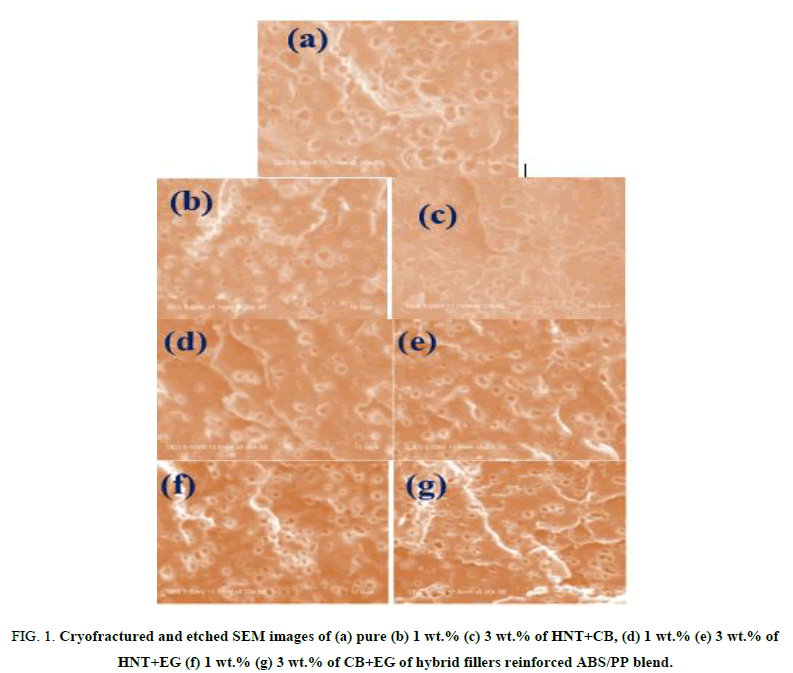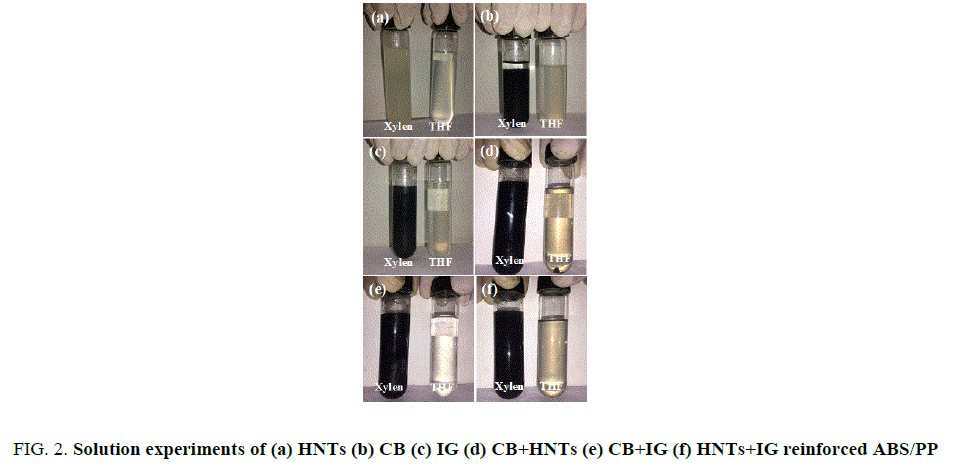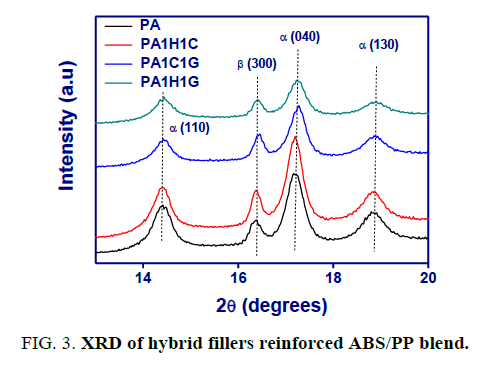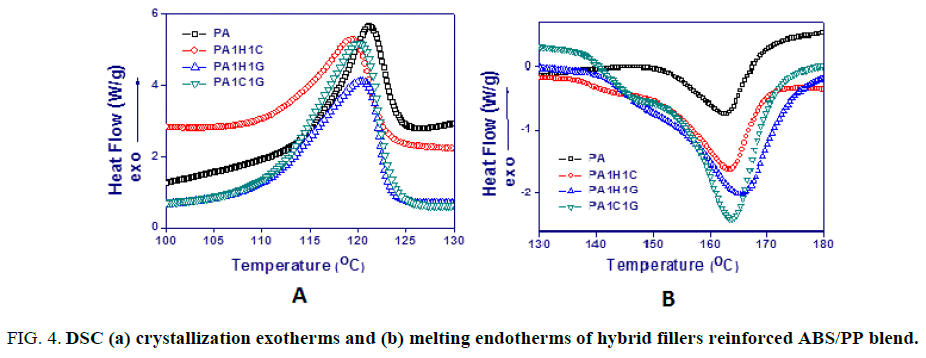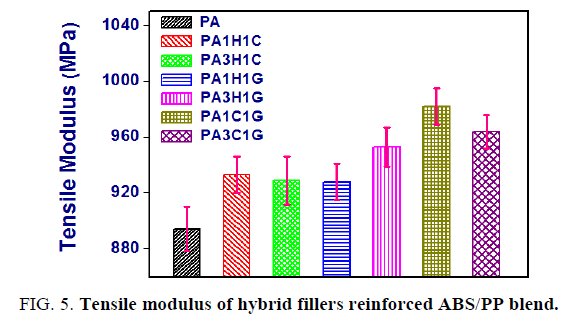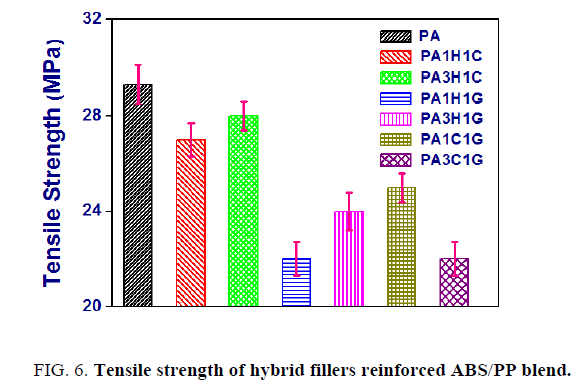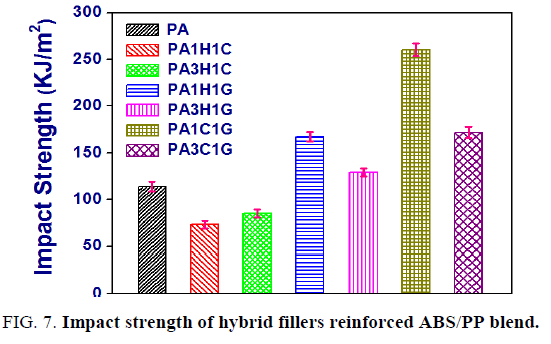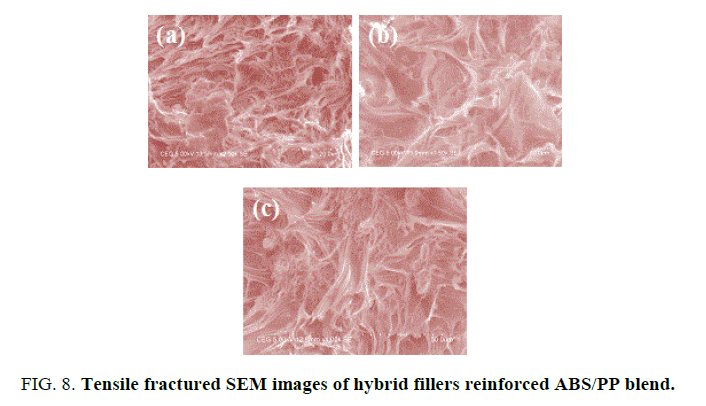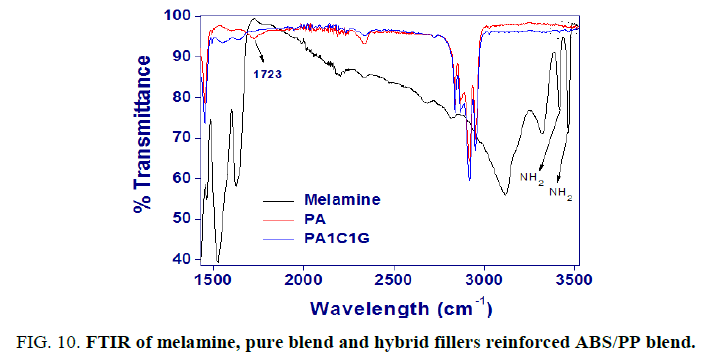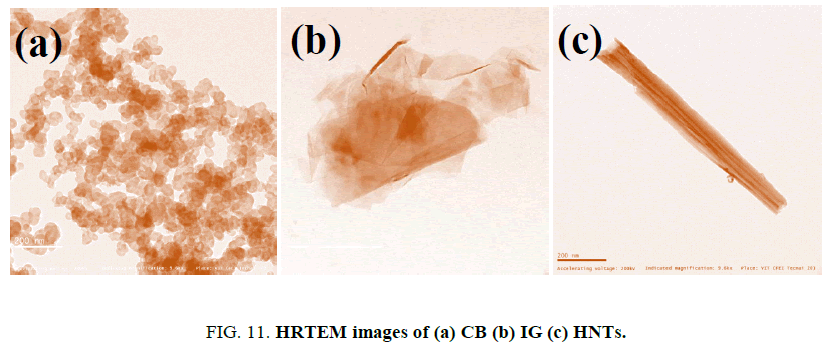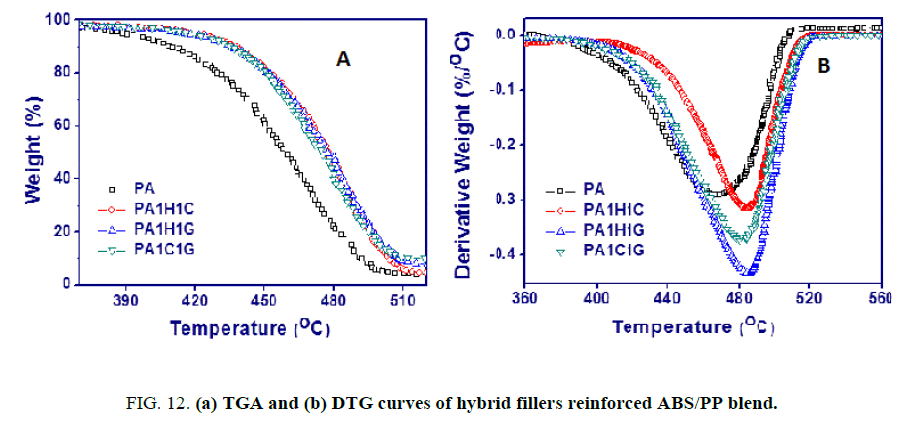Original Article
, Volume: 15( 1)Influence of Hybrid Fillers on Morphological, Mechanical and Thermal Properties of ABS/PP Blend
- *Correspondence:
- Malathi M , Condensed matter research laboratory, CCG, VIT University, Vellore, Tamilnadu, India, Tel: +919442410832; E-mail: mmalathi@vit.ac.in
Received: February 03, 2017; Accepted: March 06, 2017; Published: March 13, 2017
Citation: Saheb M, Tambe P, Malathi M. Influence of Hybrid Fillers on Morphological, Mechanical and Thermal Properties of ABS/PP Blend. Int J Chem Sci 2017;15(1):111.
Abstract
The aim of this study was to understand the influence of hybrid fillers on mechanical and thermal properties of 80/20 (wt/wt) acrylonitrile butadiene styrene (ABS)/polypropylene (PP) blends and its composites in presence of dual compatibilizer. In this study, three filler materials were used. They are Halloysite nanotubes (HNTs), carbon black (CB) and intercalated graphite (IG). The combination of the different concentration of these filler materials was melt-mixed with ABS/PP blends using counter rotating twin screw extruder followed by injection moulding. The maximum increase in tensile modulus and impact strength is for CB and IG reinforced ABS/PP blends in presence of dual compatibilizer. The enhancement in tensile modulus and impact strength is due to melt interfacial reaction in between the maleic anhydride (MA) group of compatibilizer and amine group of melamine, selective localization of hybrid fillers in PP phase, refinement in morphology, increase in percent crystallinity of PP phase and formation of form of PP crystals. Thermal stability increases for hybrid fillers reinforced ABS/PP blends in presence of dual compatibilizer as compared to pure blend. Thus, the CB and IG reinforced ABS/PP blend can be used to manufacture automotive instrument panel due to enhanced tensile and impact properties.
Keywords
Polypropylene (PP); Blends; Composites; Halloysite nanotubes (HNTs); Carbon black (CB); Intercalated graphite (IG)
Introduction
Blends of polypropylene (PP) and acrylonitrile butadiene styrene (ABS) are under investigation for various applications [1-7]. ABS/PP blends form a coarser morphology without compatibilizer. In presence of compatibilizer, the morphology of ABS/PP blends is refined. There are various different types of compatibilizer used for the refinement of the morphology of ABS/PP blend [7-11]. Patel et al. [7,8] synthesized the grafting of acrylic acid (AA) and 2-hydroxyethyl methacrylate (2HEMA) on PP chains. These grafted PP chains when mixed with ABS/PP blends refines the morphology, and subsequently improved the tensile and impact properties. In addition, grafting of maleic anhydride (MA), styrene acrylonitrile (SAN) over PP, and MA grafting over styrene-ethylene, butylene-styrene (SEBS) chains also refines the morphology of ABS/PP blends, and subsequently improved the mechanical properties [6,9,10]. Recently, Kubade et al. [11,12] utilized dual compatibilizer of PP grafted MA (PP-g-MA) and SEBS grafted MA (SEBS-g-MA) in ABS/PP blend in presence of modified and unmodified Halloysite nanotubes (HNTs), and shows remarkable improvement in tensile and impact properties as compare to uncompatibilized ABS/PP blends. Thus, in this work, PP-g-MA and SEBS-g-MA as a compatibilizer have been selected. Polymers blends like polycarbonate (PC)/ABS, polystyrene (PS)/poly (2,6-dimethyl-1,4-phenylene oxide) (PPO) blend and ABS are used as materials for automotive interiors [6]. PPO, PS and ABS being engineering thermoplastic, the cost of these polymers is higher as compare to commodity polymer like PP. Thus, blends of PP and ABS are an attractive low-cost alternative.
The addition of two or more fillers in a polymer matrix is fastest getting the attention of researchers because single reinforcing filler does not satisfy the multifunctional requirements [13-20]. In addition, filler materials are added to further enhance the properties of the polymer matrix. Recently, the combination of carbon black (CB) and multiwalled carbon nanotubes (MWNT) was added in the polymer matrix to improve the electrical and mechanical properties [21,22]. In context of increasing the mechanical properties of the polymer matrix, MWNT along with clay or other filler were also added [23-26]. From the literature review, it is clear that addition of two fillers has a synergistic effect on increasing the mechanical and electrical properties of polymer composites. Thus, the judicious selection of filler materials can influence the mechanical, electrical and thermal properties of polymer composites.
In this work, three different fillers are used. They are carbon black (CB), Halloysite nanotubes (HNTs) and intercalated graphite (IG). HNTs are rigid fillers as compared to flexible filler like carbon nanotube (CNT). HNTs have multiwalled layers with OH functional group on surface [11]. Because of the presence of functional group and weak van der Waals forces in between HNTs; HNTs can be easily dispersed in polymer matrix. CB is used as a filler material in polymer blends for modification of electrical and mechanical properties [2,3]. CB can be easily dispersed in PP matrix, due to the flexible PP chains and interfacial tension difference in between PP and CB is lower. Graphite is layered arrangement of graphene sheets separated by a spacing of 3.34 Å. Organic molecules can be inserted into the space to separate the layer spacing. Aminotriazines (melamine) are strongly adsorbed over the graphene sheets [27]. So the graphite intercalated with melamine using mechanical activation is referred as intercalated graphite (IG) in this work. HNTs and CB are available commercially at a low cost. MWNT is available commercially, but the cost is very high as compared to graphite. Since melamine is commercially available chemical; IG prepared using melamine and graphite can have significant low cost as compared to MWNT. The use of various combinations of CB, IG and HNTs can influence the mechanical properties of ABS/PP blends. In addition, the use of melamine intercalated graphite filler in the polymer matrix is first time attempted in this work. In this work the fillers combinations used are HNTs/CB, HNTs/IG and CB/IG. This combination of hybrid filler reinforced polymer blends or polymer composites were not attempted earlier. The aim of this paper is to evaluate the role of different filler combinations on mechanical and thermal properties of ABS/PP blends. The best combination of fillers in ABS/PP blend in influencing the mechanical and thermal properties can be commercially attractive in view of the availability of fillers at a large scale.
Experimental
Materials and composite preparation
The details of filler materials and polymers used in this work are summarized in Table 1. These materials were dried in a vacuum oven at 80°C before processing. Initially, hybrid fillers and polymers were premixed mechanically and then extruded using the twin screw extruder. The extruder used was of counter rotating type with L/D of 17 and screw diameter of 25 mm (S. C. Dey & Co., India). The extruder was operated at 155-210-240°C and speed of screw was 10 rpm. Extruded strands obtained from twin screw extruder were chopped using palletizer. The chopped granules of composites were injection moulded to prepare tensile, impact and flammability test specimens. Mini-injection moulding machine (S. C. Dey & Co., India) was used to prepare tensile, impact and flammability test specimens; and the machine was operated at 230°C temperature and a pressure of 7 bar. The compositional details of hybrid fillers reinforced ABS/PP blends are shown in Table 2. IG was prepared using ball milling at 200 rpm for 6 hours by adding melamine and graphite in the ration of 3:1.
| Sr. No | Sample Codes | PP (wt.%) | ABS (wt.%) | HNTs (wt.%) | CB (wt.%) |
EG (wt.%) |
PP-g-MA (wt.%) | SEBS-g-MA (wt.%) |
|---|---|---|---|---|---|---|---|---|
| 1 | PA | 72 | 18 | - | - | - | 5 | 5 |
| 2 | PA1H1C | 70.4 | 17.6 | 1 | 1 | - | 5 | 5 |
| 3 | PA3H1C | 68.8 | 17.2 | 3 | 1 | - | 5 | 5 |
| 4 | PA1H1G | 68 | 17 | 1 | - | 4 | 5 | 5 |
| 5 | PA3H1G | 66.4 | 16.6 | 3 | - | 4 | 5 | 5 |
| 6 | PA1C1G | 68 | 17 | - | 1 | 4 | 5 | 5 |
| 7 | PA3C1G | 66.4 | 16.6 | - | 3 | 4 | 5 | 5 |
Table 1: Codes of hybrid fillers reinforced ABS/PP blends.
| Sr. No | Material | Remarks | Supplier |
|---|---|---|---|
| 1 | PP | MFI of 11 g/10 min, REPOL 110MA | Reliance Industries Ltd, India |
| 2 | ABS | MFI of 19 g/10 min, Terluran GP-22 | Strylotion, India |
| 3 | SEBS-g-MA | MFI of 14 g/10 min, FG1901 G | Karton, India |
| 4 | PP-g-MA | MFI of 14 g/10 min | Pluss Polymer Ltd, India. |
| 5 | HNTs | 60 mm to 80 nm diameter | Imerys Tableware, New Zealand. |
| 6 | CB | Spherical in shape, N991 | Thermax, India. |
| 7 | Graphite | 94% purity | Stellar Material Corporation, Banglore. |
Table 2: Various materials used in this work.
Characterization
The details of various characterization techniques used for characterization of hybrid fillers reinforced ABS/PP blends are summarized in Table 3. High resolution transmission electron microscope (HRTEM) of JEOL JEM 2100 was used to characterize the morphology of hybrid fillers. The crystal structure development of PP phase of ABS/PP blend and its composites were characterizes using X-ray diffraction (XRD). XRD of D8 Advance, BRUKER was used and operated at the incident X-rays (λ=1.54 nm) and scanning range of 10° to 70°. Crystallization behaviour of ABS/PP blend and its composites was characterized using differential scanning calorimetry (DSC) using Exstar 6200 from RT instruments. The data were recorded in heating-cooling-heating cycle for all samples in the temperature range from 25°C to 240°C at a scan rate of 10°C/min under nitrogen atmosphere. The degree of crystallinity (Xc) of PP phase was calculated from the ratio of normalized heat of fusion (ΔHm, norm) of the second heating run to the heat of fusion of 100% crystalline PP, (ΔHm)100%. The (ΔHm)100% was taken as 207 J/g [11]. Thermal stability characterization was carried out using thermogravimetric analysis (TGA) on Exstar 7020 from RT instruments. The data were recorded in the temperature range of 25°C to 900°C, and at the heating rate of 10°C/min in under nitrogen atmosphere. Differential thermogravimetric (DTG) were obtained by taking first derivative data of the original weight loss dependence of the temperature. Fourier transform infrared spectroscopy (FTIR) was carried out to probe the chemical reaction between compatibilizer and filler. The spectra’s were recorded with SHIMADZU IR Affinity-1 with the wavenumber ranging from 400 cm-1 to 4000 cm-1 (Resolution 1 cm-1). Tensile testing of hybrid fillers reinforced ABS/PP blend and its composites were tested on the universal testing machine, Instron (8801) according to ASTM D638. The impact testing of hybrid fillers reinforced ABS/PP blend and its composites were tested on CEAST (Instron) pendulum impact tester according to ASTM D256 on un-notched specimens. Scanning electron microscopy (SEM) analysis was performed with Hitachi S3400, operated at 15 kV with gold sputtering.
| Sr. No | Characterization Technique | Conditions | Company |
|---|---|---|---|
| 1 | High resolution scanning electron microscopy (HRSEM) | Various magnification | FEI Quanta 200 |
| 2 | X-ray diffraction (XRD) | Wavelength l=1.54 nm, step scan with step size of 0.02° between 5° and 80° (2q) | D8 Advance, BRUKER |
| 3 | Differential scanning calorimetric (DSC) | Heating-cooling-heatingcycle, temperature range from 25°C to 240°C @ 10°C/min under nitrogen atmosphere |
Exstar 6200 from RT instruments |
| 4 | Tensile testing | ASTM-D368 | Instron (8801) |
| 5 | Impact testing | ASTM D256, pendulum impact tester. | CEAST (Instron) |
| 6 | Fourier transform infrared spectroscopy (FTIR) | 400 cm-1to 4000 cm-1 range, resolution 1 cm-1. | SHIMADZU |
| 7 | Thermogravimetric analysis (TGA) | Temperature range of 25°C to 900°C @ 10°C/min in under nitrogen atmosphere | Exstar 6200 from RT instruments |
Table 3: Various characterization techniques used in this work.
Results and Discussion
The mechanical properties of polymer blends depend on the morphology developed during processing. In general, the morphology of polymer blends are characterized by cryofracture the polymer blends followed by etching one of the polymer in the solvent, and thereafter, SEM observation to be taken. In this work, ABS/PP blends and its composites samples were brittle fractured using liquid nitrogen; and thereafter the ABS/PP blends and its composites were etched in a boiling tetrahydrofuran to remove ABS phase. SEM images of etched samples are shown in Figure. 1. Pure blend and hybrid fillers reinforced ABS/PP blend show the formation of matrix droplet morphology. As compared to pure blend, hybrid fillers reinforced ABS/PP blend show the refinement in morphology. In view to know the reason behind the refinement in the morphology of hybrid fillers reinforced ABS/PP blend, it is important to know whether the dispersion of hybrid fillers localized in PP or ABS phase. In this regard, solution experiments were carried out. For solution experiments, 3 gm of small pallets of individual filler and hybrid fillers reinforced ABS/PP blend were heated in xylene and tetrahydrofuran separately in order to dissolve PP and ABS respectively. Figure. 2shows the photographs of solutions of individual filler and hybrid fillers reinforced ABS/PP blends. Figure. 2a, shows the selective localization of HNTs in PP phase as depicted from the yellow colour solution of dissolution of HNTs/PP in xylene; Figure. 2b shows the selective localization of CB in PP phase as depicted from the black colour solution of dissolution of CB/PP in xylene; Figure. 2c shows the selective localization of IG in PP phase as depicted from the black colour solution of dissolution of IG/PP in xylene for individual filler reinforced ABS/PP blends. Figure. 2d-2f shows the photograph of hybrid fillers reinforced ABS/PP blend depicting selective localization of hybrid fillers in PP phase (black colour solution of dissolution of hybrid fillers in xylene). Selective localization of fillers in polymer blends can be explained based on the interfacial tension and glass transition temperature (Tg) [27-31]. Interfacial tension and wetting coefficient calculation suggest the affinity of fillers toward ABS. Wu et al. [29] suggests that competitive adsorption of selective localization of fillers does not always depends on the surface tension of polymer, but also depends on the flexibility of polymer chains, and low Tg have a low entropic loss of absorption on CB surface. Among PP and ABS polymers, PP is more flexible as Tg of PP is less as compare to ABS [29-32]. Thus, it can be ascribed that due to lower Tg of PP, hybrid fillers are selectively localized in PP phase. The refinement in the morphology of hybrid fillers reinforced ABS/PP blend is due to the compatibilization action of hybrid fillers in suppressing the coalescence phenomena among the dispersed droplets. The hybrid fillers act as the kinetic barrier which is not allowing the droplets to coalesce together. In addition, localization of hybrid fillers in PP phase increases the melt viscosity of PP resulting in suppression of coalescence. Similar observations have been observed by many researchers where different reinforcing fillers were compatibilizing polymer blends systems.
Figure 1: Cryofractured and etched SEM images of (a) pure (b) 1 wt.% (c) 3 wt.% of HNT+CB, (d) 1 wt.% (e) 3 wt.% of HNT+EG (f) 1 wt.% (g) 3 wt.% of CB+EG of hybrid fillers reinforced ABS/PP blend.
Figure 2: Solution experiments of (a) HNTs (b) CB (c) IG (d) CB+HNTs (e) CB+IG (f) HNTs+IG reinforced ABS/PP blend.
Crystal structure of PP chains influences the mechanical properties of PP. The addition of ABS in PP can influence the crystal structure development of PP. XRD was used to characterize the crystal structure development of PP in presence of ABS and compatibilizer. XRD spectra of Figure. 3 show the formation of α and β form of PP crystals. The formation of α and β form of PP crystals are depicted in all the samples. The peaks at diffraction angles with a corresponding plane of α and β form of PP crystals are marked in Figure. 3. The formation of a β form of PP crystals is due to ABS and SEBS-g-MA acts as a β nucleating agent. Kubade et al. [11,12] demonstrates ABS and SEBS-g-MA act as β nucleating agent for the formation of a β form of PP crystals. It is important to quantify the amount of α and β form of PP crystals in a PP phase of ABS/PP blends and its composites in order to correlate with mechanical properties. A Turner-Jones et.al32 equation was used to quantify the amount of β crystals in PP and the quantified values are tabulated in Table 4. The addition of hybrid fillers in ABS/PP blends show more content of β crystals formation. It can be ascribed due to refinement in the morphology of ABS/PP blends in presence of hybrid fillers, which facilitates more surface area of contact in between PP and ABS/SEBS-g-MA. The higher surface area of contact in between PP and ABS/SEBS-g-MA enhances the nucleation ability and forms more β form of PP crystals.
| Sr. No | Sample Codes | Kβ |
|---|---|---|
| 1 | PA | 0.17 |
| 2 | PA1H1C | 0.19 |
| 3 | PA3H1C | 0.22 |
| 4 | PA1H1G | 0.20 |
| 5 | PA3H1G | 0.22 |
| 6 | PA1C1G | 0.20 |
| 7 | PA3C1G | 0.22 |
Table 4: Kβ values of hybrid fillers reinforced ABS/PP blend.
It is not only the crystal structure of PP but also the percent crystallinity of PP phase can influence the mechanical properties of ABS/PP blends. In addition, hybrid fillers can influence the crystallization behaviour of PP phase of ABS/PP blends. DCS characterization technique was used to study the crystallization behaviour of PP phase of hybrid fillers filled ABS/PP blends. Melting endotherms and crystallization exotherms of ABS/PP blends and its composites are shown in Figure. 4. Crystallization temperature (Tc) of hybrid fillers reinforced ABS/PP blend decreases as compared to pure ABS/PP blend. Table 5 shows the values of Tc for pure and hybrid fillers reinforced ABS/PP blend. The decrease in Tc of hybrid fillers reinforced ABS/PP blends is due to the interaction between hybrid fillers and PP. Similar observation of decreasing Tc of polymer in presence of fillers were observed by many researchers [32,33]. Melting temperature (Tm) of hybrid fillers reinforced ABS/PP blend increases as compare to pure ABS/PP blend. The maximum increase in Tm is for HNTs+IG filled reinforced ABS/PP blend. It is due to the large interfacial area of contact in between HNTs+IG and PP. Percent crystallinity (Xc) of PP phase for pure blend and hybrid fillers reinforced ABS/PP blends are shown in Table 5. Xc of hybrid fillers reinforced ABS/PP blend increases as compare to pure blend. It may be due to the selective localization of hybrid fillers in PP phase. In addition, refinement in morphology results in the large surface area of contact in between ABS phase, SEBS-g-MA and PP. The large surface area of contact facilitates more PP crystal formation. The maximum increase in crystallinity is for CB+IG reinforced ABS/PP blend.
Figure 4: DSC (a) crystallization exotherms and (b) melting endotherms of hybrid fillers reinforced ABS/PP blend.
| Sr. No | Sample Codes | Tm (°C) | Tc (°C) | Xc (%) |
|---|---|---|---|---|
| 1 | PA | 163 | 121.5 | 39.2 |
| 2 | PA1H1C | 163.5 | 119.5 | 41.9 |
| 3 | PA3H1C | 166.4 | 120.1 | 49.8 |
| 4 | PA1H1G | 165.1 | 120.2 | 46.5 |
| 5 | PA3H1G | 165.6 | 120.3 | 48.8 |
| 6 | PA1C1G | 163.8 | 120.0 | 46.4 |
| 7 | PA3C1G | 164.2 | 120.5 | 52.1 |
Table 5: Melting and crystallization parameters of hybrid fillers reinforced ABS/PP blend.
It was observed that the fillers are localized in PP phase of ABS/PP blend, which has resulted in refinement in morphology of ABS/PP blend. It is expected that with the refinement in the morphology of ABS/PP blend, mechanical properties are bound to increase. Figure. 5 and 6 shows the tensile properties of hybrid fillers reinforced ABS/PP blend. The tensile modulus of hybrid fillers reinforced ABS/PP blend increases as compared to pure ABS/PP blend. The maximum enhancement is tensile modulus is for CB+IG reinforced hybrid fillers reinforced ABS/PP blend. Tensile strength of hybrid fillers reinforced ABS/PP blend decreases as compared to pure ABS/PP blend. The impact strength of hybrid fillers reinforced
ABS/PP blend is shown in Figure. 7. Impact strength decreases in case of HNTs+CB reinforced ABS/PP blend as compare to pure ABS/PP blend. While it increases for HNTs+IG and CB+IG reinforced ABS/PP blend as compare to pure ABS/PP blend. The increase in impact strength is maximum for 1 wt.% CB+4 wt.% IG reinforced hybrid fillers reinforced ABS/PP blend.
Fractography and FTIR studies have been carried out to probe the role of morphology and interaction if any in between hybrid fillers and polymers of hybrid fillers reinforced ABS/PP blends.Figure. 8 shows the tensile fracture specimens of hybrid fillers reinforced ABS/PP blends. It shows the formation of fibrils during deformation of hybrid fillers reinforced ABS/PP blends. Figure. 9 shows the impact fractured specimens of hybrid fillers reinforced ABS/PP blends. It shows a large amount of ABS droplets are intact with PP phase, depicting the interaction between nitrile group of ABS and MA of SEBS-g-MA/PP-g-MA [5] Further, Figure. 10 shows the FTIR of melamine, pure ABS/PP blend and hybrid fillers reinforced ABS/PP blends. The peak centered around 1723 cm-1 for ABS/PP blend in presence of dual compatibilizer is the characteristic peak of maleic anhydride (MA) moiety of PP-g-MA/SEBS-g-MA6. Melamine FTIR spectra shows the peaks at 3412 cm-1 and 3464 cm-1, which are amine group peaks [34]. But, with an addition of melamine modified hybrid filler in ABS/PP blends in presence of PP-g-MA and SEBS-g-MA; it is expected that amine group of melamine and MA group of PP-g-MA/SEBS-g-MA may undergo melt interfacial reaction. The FTIR of peak of melamine modified hybrid fillers reinforced ABS/PP blend show the disappearance of peak at 1723 cm-1, due to melt interfacial reaction. In addition, there are small peaks encircled at 3412 cm-1 and 3464 cm-1 in melamine modified hybrid filler in PP/ABS blends in presence of PP-g-MA and SEBS-g-MA, depicting the presence of unreacted melamine.
Figure 9: Fractured SEM images of (a) 1 wt.% (b) 3 wt.% of CB+EG, (c) 1 wt.% (d) 3 wt.% of HNT+CB (e) 1 wt.% (f) 3 wt.% of HNT+EG of hybrid fillers reinforced ABS/PP blend.
It is noted that hybrid fillers are localized in PP phase of hybrid fillers reinforced ABS/PP blends. Interaction of hybrid filler with PP phase needs to understood in order to conclude on the influence of hybrid fillers on mechanical properties of hybrid fillers reinforced ABS/PP blends. Surface chemistry and surface roughness play an important role in adhesion of two materials. Figure. 11 shows the HRTEM micrographs of CS, IG and HNTs respectively. Figure. 11b shows HRTEM micrograph of CB with the size of CB particles is in the range of 50 nm to 60 nm. Figure. 11b shows the HRTEM micrograph of layers of graphene of IG with curvatures at the edges. Figure. 11c shows the HRTEM of HNTs showing largely the smooth cylindrical surface. Carbon black has a surface with various surface heterogeneities with graphite edge as an active site [35]. Graphite has highly active defective edge sites [36]. HNTs have few hydroxyl groups on the outer surface [37]. PP interacts with the active sites of CB and IG results in the lower entropic loss, as PP has a carbon-carbon chain with lower Tg [29]. PP interacts with HNTs is through van der Waals interactions. Thus, PP is interacting with HNTs, CB and IG.
The influence of hybrid fillers on mechanical properties of hybrid fillers reinforced ABS/PP blends are discussed below. Enhancement in tensile and impact properties can be correlated with morphology development, percent crystallinity, crystal structure formation, the state of dispersion of fillers, and interaction between fillers and polymers. In case of hybrid fillers reinforced ABS/PP blend; CB, IG and HNTs are selectively localized in PP phase as established from solution experiments (Figure. 2). Droplet diameter of ABS phase of hybrid fillers reinforced ABS/PP blend reduces as compare to pure ABS/PP blend (Figure. 1). Xc of PP phase of hybrid fillers reinforced ABS/PP blends is more as compare to pure ABS/PP blend (Table 5). CB and HNTs interact with PP non-covalently. HNTs interact with PP through van der Waals interactions. PP chains are adsorbed over the active graphitic site of CB. In addition, CB has a surface roughness of 1 nm to 100 nm. The presence of IG in ABS/PP blends, there is a chemical reaction between the amine group of melamine intercalated graphite and MA group of compatibilizer (Figure. 10). It is interesting to note that melamine adsorbed strongly with carbon based material. Thus, the tensile modulus of hybrid fillers reinforced ABS/PP blend is more as compared to pure ABS/PP blend (Figure. 6). The probable reasons can be summarized are: (a) CB, IG and HNTs are hard material as compared to PP, and they are localized in PP phase; in addition they interacts covalently and non-covalently with polymers; so it shall restrict the deformation of PP chains (b) interaction between nitrile group of ABS and MA of SEBS-g-MA shall restrict the pull out of ABS droplets and contribution towards enhanced stress transfer (c) enhancement in Xc of PP phase (Table 5) (d) refinement in morphology of ABS droplets (Figure. 2). The combined effect of above-mentioned reasons contribute towards enhancement in tensile properties.
The impact properties of CB+HNTs reinforced ABS/PP blend is less as compared to pure ABS/PP blend (Figure. 7). It is due to the HNTs and CB are hard filler which acts a stress concentration sites and there is an inadequate interfacial interaction between CB/HNTs with PP, which may be responsible for rapid delamination of hybrid fillers and PP matrix results in catastrophic crack propagation. The enhancement in impact properties is due to the HNTs/IG and IG/CB pair acts a stress concentration sites, and there is a interfacial interaction between IG with PP-g-MA, which may be responsible for restricting delamination of hybrid fillers and PP matrix results in preventing catastrophic crack propagation. In addition, due to resistance to delamination, the load is transferred to ABS droplets; under the applied load ABS droplets pull out can occur due to void growth at interface or cavitaion of ABS may results in more energy absorption (Figure. 9).
The enhancement in tensile and impact strength is 9.8% and 128.1% for IG+CB reinforced ABS/PP blend. It is to be noted that wherever HNTs are mixed with CB or IG, mechanical properties obtained are not significantly enhanced; while mechanical properties enhancement is highest for IG+CB reinforced ABS/PP blend. The main reason is; HNTs have the large smooth surface area, while CB surface roughness in nanometres and IG edges are curled. Thus, CB and IG due to rough and curled edges are contributing effectively towards enhancement in mechanical properties of IG+CB reinforced ABS/PP blend.
It is expected that an addition of hybrid fillers in ABS/PP blends can influence the thermal stability of polymers. Figure. 12 shows the thermogravimetric (TG) and differential thermogravimetric (DTG) curves of hybrid fillers filled ABS/PP blend. TG curves of pure ABS/PP blend and hybrid fillers filled ABS/PP blends show one step degradation of the polymer. The maximum degradation of ABS/PP blends and its composites were calculated by taking differential of TG curves and is shown in Figure. 12b. The TG curves shifts to a higher temperature for hybrid fillers filled ABS/PP blends as compare to pure ABS/PP blend (Figure. 12a). This observation depicts the enhancement in thermal stability of ABS/PP blends in presence of hybrid fillers. The maximum degradation temperature is higher for hybrid fillers filled ABS/PP blends depicting enhanced thermal stability (Figure. 12b). The highest maximum degradation temperature for HNTs/CB and IG/HNTs filled ABS/PP blends is ~ 484°C. While, IG/CB hybrid fillers ABS/PP blends is ~480°C. This observation shows, whenever HNTs is present as one of the filler, maximum thermal degradation temperature is higher because HNTs is a flame retardant material. Several researchers studied the influence of hybrid fillers of electrical and mechanical properties of composites [38-43]. The incorporation of multiwalled carbon nanotubes (MWNT) and CB together show a lower percolation threshold for polymer composites as compared to polymer/CB composites [38-42]. The incorporation of CB and silica in styrene butadiene rubber (SBR)/ABS blends show an improvement in mechanical properties [42]. Hybrid micro fillers of molybdenum disulfide, silica and alumina influence the mechanical properties of polyamide66/polytetrafluoroethylene blend [43]. So far, no studies have been reported on hybrid fillers reinforced ABS/PP blends. In this work, silica and carbon-based hybrid fillers were used. In general, silica based fillers are added to improve the mechanical properties of polymer blends, while carbon based fillers are added to improve mechanical as well as electrical properties. This work only concentrates on the mechanical behaviour of hybrid fillers filled ABS/PP blends. The hybrid filler of CB/IG reinforced with ABS/PP blend show higher mechanical properties as compare to HNTs/CB and HNTs/IG filled ABS/PP blends.
The use of HNTs, CB and IG as hybrid fillers in polymer blends is first time reported by any research group. The main finding of this paper is the significant enhancement in tensile and impact properties of CB+IG reinforced with ABS/PP blend. The main reasons for significant enhancement in tensile and impact properties of CB/IG reinforced ABS/PP blend are: (a) CB+IG fillers refine the morphology of ABS/PP blends. (b) CB+IG are selectively localize in PP phase was demonstrated. (c) CB+IG dispersion helps in the formation of more β form of PP crystals. (d) There exists a melt interfacial reaction in between MA group of PP-g-MA/SEBS-g-MA with the amine group of melamine. (e) Percentage crystallinity of PP phase increases with an addition of CB/IG hybrid fillers in ABS/PP blends. Based on the above observation, in the broader context of the application of this work, hybrid filler of CB+IG reinforced ABS/PP blend can be used to make the automotive instrument panel due to its high tensile, impact and thermal properties. The availability of CB, graphite and melamine make the ABS/PP blend and its CB+IG composites commercially attractive.
Conclusion
Hybrid fillers reinforced ABS/PP blends show the presence of α and β form of PP crystals. ABS and SEBS-g-MA act as a β -nucleating. The content of β crystals, % crystallinity is more for hybrid fillers reinforced ABS/PP blend as compare to pure ABS/PP blend. Refinement in morphology was observed for hybrid fillers reinforced ABS/PP blends. In addition, there is a chemical reaction in between amine group of melamine and maleic anhydride group of the compatibilizer. The tensile modulus of hybrid fillers reinforced ABS/PP blends increases as compare to pure ABS/PP blend. The maximum enhancement is tensile modulus is for CB+IG reinforced hybrid fillers reinforced ABS/PP blend. The maximum increase in tensile and impact strength is for CB+IG reinforced hybrid fillers reinforced ABS/PP blend. The enhancement in mechanical properties are due to refinement in morphology, improved crystallinity, a higher amount of formation of β-form of PP crystals and melt interfacial reaction. Thermal stability is also enhanced in the case of hybrid fillers reinforced ABS/PP blend.
Acknowledgement
The authors acknowledge SERB DST for startup grant of Young Scientist (SERC-ET-032/2012).
References
- Khare RA, Bhattacharyya AR, Kulkarni AR.Melt-mixed polypropylene/acrylonitrile-butadiene-styrene blends with multiwall carbon nanotubes: Effect of compatibilizer and modifier on morphology and electrical conductivity. Polym Eng Sci.2011;120:2663-72.
- Saheb M, Tambe P, Malathi M. Influence of Halloysite nanotubes and intumescent flame retardant on mechanical and thermal properties of 80/20 (wt/wt) PP/ABS blend and their composites in the presence of dual compatibilizer. J Thermplas Compos Mat. 2017.
- Hom S, Bhattacharyya AR, Khare RA, et al.PP/ABS blends with carbon black: Morphology and electrical properties. J Appl Polym Sci.2009;112:998-1004.
- Khare RA, Bhattacharyya AR, Kulkarni AR, et al.Influence of multiwall carbon nanotubes on morphology and electrical conductivity of PP/ABS blends. J Polym Sci: Part B Polym Phy.2008;21:2286-95.
- Bonda S, Mohanty S,Nayak SK.Influence of compatibilizer on mechanical, morphological and rheological properties of PP/ABS blends, Iran. Iran Polym J.2014;23:415-25.
- Bose S, Bhattacharyya AR, Häußler L, et al.Influence of multiwall carbon nanotubes on the mechanical properties and unusual crystallization behavior in melt-mixed co-continuous blends of polyamide and acrylonitrile butadiene styrene. Polym EngSci.2009;49:1543-53.
- Patel C, Brahmbhatt RB, Sarawade BD, et al.Morphological and mechanical properties of PP/ABS blends compatibilized with PP-g-acrylic Acid. J Appl Polym Sci.2001;81:1731-41.
- PatelAC, BrahmbhattRB, Devi S.Mechanical properties and morphology of PP/ABS blends compatibilized with PP-g-2-HEMA. J Appl Polym Sci.2003;88:72-78.
- Eskandari P, Mazidi MM,Aghjeh KR.In Situreactive compatibilization of PP/ABS blends via Friedel-crafts alkylation reaction. Polym Soc Kor.2016;24:14-24.
- Kum K, Sung Y, Kim YS. et al,Effects of Compatibilizer on mechanical, morphological, and rheological properties of polypropylene/poly(acrylonitrile-butadiene-styrene) blends. Macromol Res.2007;15:308-14.
- Kubade P,Tambe P.Influence of Halloysite nanotubes (HNTs) on morphology, crystallization, mechanical and thermal behaviour of PP/ABS blends and its composites in presence and absence of dual compatibilizer. Compos Interface.2016;5:433-51.
- Kubade P, Tambe P. Influence of surface modification of Halloysite nanotubes and its localization in PP phase on mechanical and thermal properties of PP/ABS blends. Compos Interface.2016;24:469-87.
- Tambe PB, Bhattacharyya AR, Kamath S, et al.Structure property relationship studies in amine functionalized multiwall carbon nanotubes filled polypropylene composite fiber. Polym Eng Sci.2012;52:1183-94.
- Tambe PB, Bhattacharyya AR, Kulkarni AR.The influence of melt-mixing process conditions on electrical conductivity of polypropylene/multiwalled carbon nanotubes composites. J App Polym Sci.2012;127:1017-26.
- Sreekanth MS, Panwar AS,Potschke P, et al.Influence of hybrid nano-filler on the crystallization behaviour and interfacial interaction in polyamide 6 based hybrid nano-composites. Phys Chem. 2015;17:9410-19.
- Bhingardive V, Suwas S, Bose S. New physical insights into the electromagnetic shielding efficiency in PVDF nanocomposites containing multiwall carbon nanotubes and magnetic nanoparticles. RSC Adv. 2015;5:79463-72.
- Kumar P, Mural S, Pawar SP, et al.Engineering nanostructures by decorating magnetic nanoparticles onto graphene oxide sheets to shield electromagnetic radiations. ACS Appl Mater Interfaces.2015;7:16266-78.
- Pawar SP, Stephen S, Bose S.Tailored electrical conductivity, electromagnetic shielding and thermal transport in polymeric blends with graphene sheets decorated with nickel nanoparticles. Phys Chem. 2015;17:14922-30.
- Biswas S, Kar GP, Bose S.Microwave absorbers designed from PVDF/SAN blends containing multiwall carbon nanotubes anchored cobalt ferrite via a pyrene derivative. J Mater Chem. 2015;3:12413-26.
- Biswas S, Kar GP, Arora D.A unique strategy towards high dielectric constant and low loss with multiwall carbon nanotubes anchored onto graphene oxide sheets. RSC Adv. 2015;5:24132-38.
- Burmistrov N,Gorshkov I,Ilinykh D, et al.Improvement of carbon black based polymer composite electrical conductivity with additions of MWCNT. Compos Sci Techno.2016;129:79-85.
- Matchawet S, Kaesaman A, Bomlai P, et al.Effects of multi-walled carbon nanotubes and conductive carbon black on electrical, dielectric, and mechanical properties of epoxidized natural rubber composites. Polym compos. 2015.
- Mohsin MEA,Arsada A,Alothman OY.Enhanced thermal, mechanical and morphological properties of CNT/HDPE nanocomposite using MMT as secondary filler. World Acad Sci.2014;8:117.
- Roy S, Srivastava SK, Pionteck J, et al.Montmorillonite-multiwalled carbon nanotube nanoarchitecture reinforced thermoplastic polyurethane. Polym compos.2014;37:1175-8.
- Zhang M, Zhai Z, Li M, et al.Epoxy nanocomposites with carbon nanotubes and montmorillonite: Mechanical properties and electrical insulation.J Compos Mat. 2015.
- Nurul MS,Mariatti M. Polym Bull. Effect of hybrid nanofillers on the thermal, mechanical, and physical properties of polypropylene composites.2013;70:871-84.
- Leon V, Quintana M, Herrero MA.Few-layer graphenes from ball-milling of graphite with melamine.Chem Commun. 2011;47:10936-8.
- Bose S, Bhattacharyya AR, Khare RA, et al.The role of specific interaction and selective localization of multiwall carbon nanotubes on the electrical conductivity and phase morphology of multicomponent polymer blends. Polym Eng Sci.2011;51:1987-2000.
- Wu G, Asai S,Sumita M.Entropy penalty-induced self-assembly in carbon black or carbon fiber filled polymer blends. Macromol.2002;35:945-51.
- Tjong SC, Meng YZ.Effect of reactive compatibilizers on the mechanical properties of polycarbonate/poly(acrylonitrile-butadienestyrene) blends. Eur Polym J.2000;36:123-9.
- Wang Z, Zhang Y, Du J, et al. Effect of acrylonitrile-butadiene-styrene copolymer (ABS) on ß-nucleation in ß-nucleated polypropylene/ABS blends. Polym Bull. 2012;69:847-59.
- Thayumanavan N, Tambe PB, Joshi GM, et al.Effect of sodium alginate modification of graphene (by ?anion-p? type of interaction) on the mechanical and thermal properties of polyvinyl alcohol (PVA) nanocomposites. Compos Interface.2014;21:487-506.
- Thayumanavan N, Tambe PB, Joshi GM, et al. Effect of surfactant and sodium alginate modification of graphene on the mechanical and thermal properties of polyvinyl alcohol (PVA) nanocomposites. Cellulose Chem Tech.2015;49:69-80.
- Jawaid S, Talpur FN, Afridi HI, et al.Quick determination of melamine in infant powder and liquid milk by Fourier transform infrared spectroscopy. Anal Methods.2014;6:5269-73.
- Schroder M, Schuster RH. Characterisation of Surface Activity of Carbon Black and its Relation to Polymer-Filler Interaction. Macromol Mater Eng. 2007;292:885-916.
- Xu Y, Li J.The interaction of molecular oxygen with active sites of graphite: a theoretical study.Chem Phy Let.2004;400:406-12.
- Du M, Guo B, Cai X, et al.Morphology and properties of halloysite nanotubes reinforced polypropylene nanocomposites. e-Polym.2008;130:1-14.
- Ma P, Liu M,Zhang H, et al.Enhanced Electrical Conductivity of Nanocomposites Containing Hybrid Fillers of Carbon Nanotubes and Carbon Black. ACS App MatInterfaces.2009;1:1090-6.
- Socher R, Krause B, HermaschS.Electrical and thermal properties of polyamide 12 composites with hybrid fillers sysHRTEMs of multiwalled carbon nanotubes and carbon black. Composites Sci Tech.2011;71:1053-9.
- Zha W, Li R, Liao J. et al, High performance hybrid carbon fillers/binary-polymer nanocomposites with remarkably enhanced positive HRTEMperature coefficient effect of resistance. J Mater Chem A.2013;1:843-51.
- Bokobza M, RahmaniC, Belin J,et al. Blends of Carbon Blacks and Multiwall Carbon Nanotubes as Reinforcing Fillers for Hydrocarbon Rubbers. J Polym Sci: Part B: Polym Phys.2008;46:1939-51.
- Noriman N, Ismail H.Properties of Styrene Butadiene Rubber (SBR)/Recycled Acrylonitrile Butadiene Rubber (NBRr) Blends: The Effects of Carbon Black/Silica (CB/Sil) Hybrid Filler and Silane Coupling Agent, Si69. J of AppPolym Sci.2009;124:19-27.
- Rudresh B, RavikumarB, Madhu D.Hybrid Effect of Micro Fillers on the Mechanical Behavior of Polyamide66/Polytetrafluoroethylene Blend. Ind J Adv in Chem Sci.2016;4:77-84.
